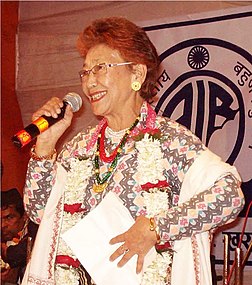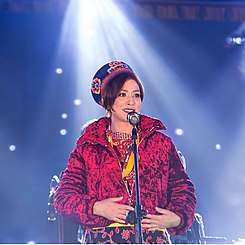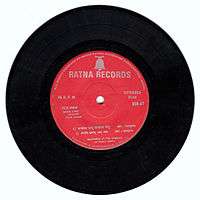Music of Nepal
Music of Nepal refers to the various musical genres played and listened to in Nepal. With more than fifty ethnic groups, the music of Nepal is highly diverse. Genres like Tamang Selo, Dohori, Adhunik Geet, Bhajan, Filmi music, Ghazal, Classical music,teej songs and Ratna music are widely played and popular, but many other less common genres are yet to be cataloged. Western musical genres like Rock, Metal, Hip-Hop, Rap, R&B also regularly feature on the Nepalese music charts. Most of the country's musical bands are based in the Kathmandu valley. Musical genres from Tibet and India have greatly influenced Nepalese music.
| Music of Nepal | |
|---|---|
| General topics | |
| Genres | |
| |
| Specific forms | |
| |
| Media and performance | |
| Music festivals | Goon lā |
| Music media | |
| Nationalistic and patriotic songs | |
| National anthem | "Sayaun Thunga Phulka" |
Genres
Dohori
Dohori is a genre of Nepali folk music and has roots in the rural courtship traditions. In Nepali, Dohori literally means from both sides or a debate. This debate is in musical rhythm, and involves quick and witty poetry. The two teams taking part in a Dohori usually involves boys and girls in rival teams. The song starts with a question, usually from the boys' side. The girl follows the question with a quick response and the two teams continue the musical conversation.
Dohori songs can last for as long as a week. The length of the Dohori depends on the quick thinking ability and wit of the players.[1]
Adhunik Geet
Adhunik Geet or modern songs are popular songs in Nepal and is also known as sugam sangeet. These of songs are soft and melodious. One of the most famous singers of this genre was late Narayan Gopal who was also known as a "Swar Samrat" meaning King of 'Voice' in Nepali and gave hits like "Euta Manchhe Ko", and "Yeti Dherai Maya Dii". Aruna Lama was one of the well-known singers of Nepali music.[2] She is popularly known as the "Nightingale of the Hills". She has sung hundreds of Nepali songs.[3]
Classical
There are numerous professional classical musicians in the Kathmandu Valley. Bands such as, Sur-Sudha,[4] Sukarma,[5] Trikaal,[6] Kutumba [7]are popular and well known in Nepal. Classical music organizations such as Kalanidhi Indira Sangeet Mahavidyalaya,[8] Nepal Sangeet Vidyalaya, SK Gurukul Sangeet Pathshala, Narayan Music Academy, Gandharva Sangeet Vidyalaya, Shree Sangeet Pathshala, Kirateswor Sangeet Ashram, Kapan Sangit Sarowar, Yalamaya Kendra[9], Ram Mandir, Gurukul Sangeet Pathshala, Atul Music Memorial Gurukul[10] etc. have been continuously contributing towards the development of Nepali classical music. Some renowned classical musicians are Tara Bir Singh Tuladhar (born 1943), Bijaya Vaidya, Prem Rana, Manose Singh (born 1979), Mohan Sunder Shestra (born 1943), Surendra Shesthra and Sur Sudha.
Ethnic music
Maithili Music
Maithili Music is one of the most ancient types of music in South Asia . It originated from Mithila region which is now divided between India and Nepal. No on knows exactly when Maithili Music came into existence, probably due to the length of its history, but its age indicates that it might have helped other music develop and flourish in India and Nepal.
Although Maithili music is usually played by classical instruments, it has been modernized and now uses various modern instruments. Some significant contributors to this music style are Maha Kavi Vidyapati Thakur, Udit Narayan Jha and Sharda Sinha.[11]The region's folk songs are associated with the various events in the life of an ordinary person.

Tamang music

The Tamang community is well known for the Damphu, a traditional instrument. Tamang Selo music is accompanied by the Damphu and Tungna. It is said that British people derived the idea of making drum sets from Damphu during their stay in India. Western and Indian instruments influences are also seen in some modern Tamang Selo music.
Hira Devi Waiba is hailed as the pioneer of Nepali folk songs. She has sung about 300 songs throughout her musical career of 40 years.[12] After Hira Devi Waiba died in 2011, her son Satya Waiba and daughter Nanveet Aditya Waiba took upon the task of reviving her songs, re-recorded them with a new sound and released them in Navneet's voice.[13][14] They named the album 'Ama Lai Shraddhanjali - Tribute to Mother'.[15]
Newa music
Newa music, also called Newar Music, is a form of traditional music developed in Nepal by the Newars. The music has its roots in classical Hindu and Buddhist music and evolved with the incorporation of folk music of the Kathmandu valley and its peripheries. Instruments used are mainly percussion and wind instruments. Notable Newar singer Narayan Gopal. Regarded one of the cultural icons in Nepal, he is referred as "Swar Samrat" (Nepali: स्वर सम्राट, meaning: Emperor of Voice) in Nepali music. He is also known as "Tragedy King" owing to his numerous tragedy songs.

"Dhime" a traditional drum, is used by the Newar People in many occasions.
Gurung music
Gurungs have an ancient tradition of Rodhi [16] where young people meet, sing and dance to folk songs, and share their views. Young men and women at Rodhi often sing the Dohori. Some musical dances like Ghantu and Chudka are still in existence, and is performed in many Gurung villages. These dance forms are centuries old and are performed either solo or in a group. Music also plays a big role in the Gurung ritual of Argum, which is performed when someone in the community dies.[17] Notable Gurung singer - Khem Raj Gurung.
Kirat music
The Yakthungs (Limbu) have various forms of songs, dances and musical instruments. Of them, Dhan Naach (paddy dance)[18] and Chyabrung (Dhol Nach "drum dance")[19] are most popular. Khambu celebrate Sakela, a dance performed during the occasion of "Udauli" and "Ubhuali" which is the most important festival of Khumbu (Rai, Kirat). Sakela which is sometimes wrongly referred as Chandi Naach. Chandi is a Hindu goddess and is not related with the Kirat culture. Many dance forms involve rituals and religious offerings towards Mundhum.
Magar music
Salaijo, Kauda and Sorathi are the three exclusive musical genres of Magar music. Notable Magar singer - Master Mitrasen Thapa Magar
Sherpa music
Sherpa music is based on Tibetan Buddhism. It is similar to music of Tibet around the trans-Himalayan region. Tibetan music is mostly religious music, reflecting the influence of Tibetan Buddhism.
"With influence from Tibet, this Nepalese music is characterized by unison singing and occasional accompaniment on the damian, a stringed instrument in the lute family that provides a strong rhythmic base. The musicians generally sing in Helambu (a Sherpa-Tibetan dialect) and sometimes in Tibetan on themes of religion, a desire for material wealth, the natural landscape, and a “sense of an ordered world in contrast to the nomadic pattern of many peoples’ lives” (Bishop). Liner notes include a description of the village and its music, track notes, and lyrics in Helambu/Tibetan and English".[20]
Tharu music
Tharu music is also one of the ancient types of music still played in Nepal. The Tharu people sing songs like Sajana, Maghiya, and Dashainya mostly in the western parts of Nepal.
Music Influenced by other regions of the World
These are musical genres which were introduced to Nepal from outside and thrived.
Bhajan
A bhajan is a devotional song praising and sometimes calling upon the Gods. It has no fixed form; it may be as simple as a mantra or kirtan. It is usually lyrical, expressing love and prayer for the Divine. Shiva, Krishna, Vishnu and Sai Baba bhajans are popular in Nepal.[21] Notable Bhajan singers Bhakta Raj Acharya, Koili Devi Mathema.
Filmi music
Filmi music is popular in Nepal and produced for mainstream motion pictures. Cinema in Nepal has a short history hence filmi music is still evolving.
Gazal
The Gazal is a poetic form of music consisting of rhyming couplets and a refrain, with each line sharing the same meter. A gazal may be understood as a poetic expression of pain, loss and separation, beauty of love and nature. It is a delicate form of poetry and music. The form is ancient, originating in 6th-century Arabic verse. Gazals spread into South Asia in the 12th century owing to the influence of Sufi mystics and the courts of the new Islamic Sultanate in India and South Asia. Although the gazal is a form of Dari and Urdu poetry, its influence can be seen in the poetry of many languages of the Indian sub-continent. Motiram Bhatta introduced the written form of gazal in Nepali language circa 1890. Seturam Shrestha (1891-1941) has been credited with pioneering gazals in Nepal.[22]
Western music
Rock/Metal
Pop
Hip Hop
- Yama Buddha
- VTEN
- Girish Khatiwada
- B-8eight
- Laure
Awards
With the growth and development of the Nepali music industry, different award ceremonies are held in different parts of the country, some focusing local talents. Awards of national level are held each year by some media houses, namely Hits FM,[23] Image FM,[24] Radio Kantipur Music Awards.[25]
Atul Memorial Music Gurukul,[26] was established in 2003 in memory of Nepali Tabla Maestro Atul Gautam. Since then the organization has been awarding Nepali classical maestros once a year on the occasion of Atul Jayanti.
- "Dohori Geet". Archived from the original on 2016-12-28.
- Nepali Songs, Lyrics. "Narayan Gopal Songs lyrics". Nepali Songs Lyrics is Site for providing Nepali Songs Lyrics. Retrieved 2018-02-26.
- Roy, Barun (2003-09-01). Fallen Cicada: Unwritten History of Darjeeling Hills. Barun Roy.
- "Sur Sudha - Playing for Change". Playing for Change. Retrieved 2018-03-01.
- "Sukarma".
- "Himalayan Jam: World music group Trikaal blends Nepali folk music with Indian, jazz and Latin sound | World Music Central.org". worldmusiccentral.org. Retrieved 2018-03-01.
- "Kutumba (band) | World top Artists - Facemeu.com first nepali infotainment web". facemeu.com. Retrieved 2018-02-26.
- "::Kalanidhi Indira Sangeet Mahavidyalaya:: The very ancient traditional, folk and classical music is living heritage of Nepal". www.kalanidhisangeet.org. Archived from the original on 2017-09-17. Retrieved 2017-10-03.
- "Yalamaya Kendra". Archived from the original on 2018-02-15.
- "Atul Memorial Gurukul". www.atulmemorialgurukul.org.np. Archived from the original on 2017-07-27. Retrieved 2017-10-03.
- "Maithili Music of India and Nepal : SAARC Secreteriat". SAARC Music Department. South Asian Association For Regional Cooperation. Retrieved 26 August 2016.
- "Pioneer of Nepali folk songs". www.telegraphindia.com. 2011-01-20.
- "Daughter revives mother's songs". The Telegraph. Retrieved 2018-03-12.
- "Songs of Tribute". Archived from the original on 2017-12-12.
- "फरिया ल्याइदेछन् तेइ पनि राता घनन !". Sambad Post. 2017-11-04. Archived from the original on 2018-03-12. Retrieved 2018-03-12.
- "Rodhi Ghar".
- "Death ritual music of the Gurungs". Archived from the original on 2018-02-15.
- "Dhan Naach". Archived from the original on 2018-02-15.
- "Chyabrung Dance". Archived from the original on 2018-02-15.
- "Music of a Sherpa Village". www.folkways.si.edu.
- "Bhajan".
- "Seturam Shrestha" (PDF).
- "Hero Hits FM Music Awards 2074 | Wave Magazine". wavemag.com.np. Retrieved 2018-03-04.
- "Image Award".
- "Radio Kantipur Music Awards".
- "Atul Memorial Gurukul".